
Wine Culture and Information since 2002 - Volume 22
 Wine Culture and Information since 2002 - Volume 22 |
|
Contrasts of Cinque Terre and Colli Martani GrechettoTwo significant and representative white wines in their respective regions – Liguria and Umbria – are being compared in the glasses of the tasting by contrast of this month |
|
Liguria and Umbria have nothing in common, except they are two regions of Italy. The former faces completely towards the sea while having a dense network of hills behind; the latter is the only peninsular region to not bordering the sea, however it has many mountains and hills. Yet Liguria and Umbria, in enological terms, have a lot in common and, specifically, the historical vocation for the cultivation and production of white wines. In both regions we find, of course, interesting and significant examples of red wines, however it is the white ones that historically represent these regions the most. Two of them, produced in territories recognized as Denominazione d'Origina Controllata (Denomination of Controlled Origin, DOC) are the protagonists of this month's tasting by contrast, wines differing in character, territory and – of course – in the grapes that make them. Cinque Terre, in fact, is a wine produced with three distinct varieties – Vermentino, Bosco and Albarola – while Colli Martani Grechetto is produced, according to its production disciplinary, with Grechetto in prevalence therefore, at the discretion of the producer, alone. To better appreciate these two wines, it is always preferable to refer to productions carried out with fermentation and aging in inert containers, therefore avoiding those made with the use of casks and barriques. In fact, it is not a matter of a prejudice towards wooden containers, however for these two wines, the aging technique in cask tends to excessively cover the specific qualities of the grapes used for their making. Furthermore, this month's tasting by contrast aims to compare the enology of the sea to the one of hills. Cinque Terre benefits from the influence of sea breeze and maritime climate, a factor totally absent in Colli Martani Grechetto which originates from the green hills of Umbria.
|
|
Viticulture in Liguria is never a simple thing, especially the one in the suggestive Cinque Terre. A territory located between the sea and steep cliffs, the vines are often cultivated in conditions that are not exactly easy, especially for the harvesting operations. Despite all that, these land make white wines of excellent quality and, not least, an absolute masterpiece of Ligurian and Italian enology: Cinque Terre Sciacchetrà. At the foundation of the wine production of this wine-growing area – recognized as Denominazione d'Origine Controllata (Denomination of Controlled Origin, DOC) – we find three white grape varieties: Vermentino, Bosco and Albarola. It is a combination of great interest, made up of three varieties capable of creating, with their own peculiarities and characteristics, white wines with a pleasing personality. The Denomination of Controlled Origin Cinque Terre extends over a small area in the province of La Spezia and includes the municipalities of Monterosso, Riomaggiore and Vernazza, as well as “Tramonti di Biassa” and “Tramonti di Campiglia” in the municipality of La Spezia. The grapes used for the production of Cinque Terre, as already said, are Vermentino, Bosco and Albarola. Of them, Vermentino is certainly the variety enjoying the greatest spreading and enological glory, a famous grape with which are made excellent wines in many Italian regions. The characteristics of Vermentino are well present and perceptible in the wines of Cinque Terre, a variety capable of giving both elegance and character. Bosco, a grape of uncertain origins, is typical of Liguria and its presence is almost limited to the Cinque Terre area. Even the third variety used in this wine – Albarola – has a rather limited spreading, mainly in the Cinque Terre area and in some parts of Tuscany. In this regard, it must be said this variety has evident genetic analogies with Bianchetta Genovese grape and, in fact, is considered by many to be the same. Finally, due to the particular characteristics of the territory, the viticulture of the Cinque Terre is considered heroic. The hills steeply sloping towards the sea, in fact, make cultivation and harvesting operations not exactly easy.
|
||||
|
Landscape and territory quite different the ones typical of Umbria, the region where Colli Martani is located, the area where the second wine of the tasting by contrast of this month is produced. In this large hilly area, the protagonists of the vineyards are undeniably Grechetto and Sangiovese. In our tasting we will focus on Grechetto, a native white grape of Umbria and widespread throughout the region. Speaking of Grechetto, however, is never simple, due to the presence of two main clones which make distinct wines. The first one, and probably the best known, is reported in the Italian Directory of Wine Grape Varieties as “G5”, commonly known as “Grechetto di Todi”, analogous to the Pignoletto grape present in the Romagna area. The second one is identified as “G109” and takes the name of “Grechetto di Orvieto”. The two clones, despite the name, have no genetic or enological analogy, therefore they are two distinct varieties. In this regard, it should be noticed the name “Grechetto” suggests a possible Greek origin, specifically, the historical custom of attributing names recalling this country to all those grapes that were thought to have been introduced from Magna Graecia. It must also be considered in past centuries it was moreover customary to attribute “Greek” names also to those grape varieties capable of making wines “in the Greek style”. To overcome the confusion that has arisen over time between the two main clones, today we usually refer to Grechetto to the variety belonging to the G109 clone (Grechetto di Orvieto), while the G5 clone (Grechetto di Todi) generally takes the name of Grechetto Gentile. The latter is the clone mainly used for the production of Colli Martani Grechetto and is also found in many other white wines of Umbria. A variety capable of making wines of good structure, it is usually vinified in inert containers in order to preserve the characteristic olfactory profile and its good acidity.
|
The choice of wines we will pour into the glasses of this month's tasting by contrast is not difficult. Both wines, in fact, are quite common and available in the market, therefore the choice of the two bottles is certainly easy. As for Colli Martani Grechetto, it should be considered that – according to its production disciplinary, as well as in that of many Italian DOC wines – Grechetto must be present for at least 85%, therefore we will pay attention on choosing a wine produced with this variety alone. Cinque Terre, on the other hand, is always produced with Vermentino, Bosco and Albarola, each of these varieties can be present for a maximum of 40%. This leaves producers the choice in creating their composition of Cinque Terre, however, in most cases, the dominant variety is Vermentino. We will also pay attention to the vinification technique, preferring wines fermented and aged in inert containers, preferably steel tank. As for the vintage, we will choose bottles belonging to the last and most recent harvest. The wines are poured into tasting glasses at a temperature of 10 °C. (50 °F) Let's pour Cinque Terre and Colli Martani Grechetto into their tasting glasses and begin the evaluation by examining the appearance of the two wines. The first wine we evaluate is Cinque Terre, produced with Vermentino, Bosco and Albarola. Let's tilt the glass over a white surface and observe the base. The Ligurian wine shows a brilliant straw yellow color and, by observing the edge of the glass, towards the opening, where the liquid mass becomes thin, we notice a greenish yellow nuance, also proving its young age. The transparency of Cinque Terre is very high: the object placed in contrast between the glass and the white surface is perfectly visible. Let's now focus our attention on the appearance of Colli Martani Grechetto and, as for the previous wine, we tilt the glass over the white surface. The color of the Umbrian wine reveals a bright straw yellow color, sometimes more intense than Cinque Terre. The nuance of Colli Martani Grechetto, observed at the edge of the glass, confirms the straw yellow color although with an evident greenish hue. Again, transparency is very high. The aromas characterizing Cinque Terre and Colli Martani Grechetto are quite different, although in both cases we can perceive aromas directly recalling white pulp fruits as well as yellow and white flowers. Moreover, in both cases we can perceive aromas recalling dried fruit, specifically, almond for Cinque Terre – mainly given by Vermentino – and hazelnut for Grechetto. In Cinque Terre can be mainly perceived aromas of apple, pear and citrus fruit, including floral aromas recalling hawthorn and broom. Furthermore, the Ligurian wine is characterized by a pleasing mineral sensation and, often, aromas recalling aromatic herbs, such as wild fennel. Colli Martani Grechetto, on the other hand, is characterized to the nose by aromas of apple, pear, plum and lemon to which are added the pleasing floral hints of hawthorn and broom, sometimes chamomile. In both wines it is possible to perceive sensations of exotic fruit, in particular pineapple. Let's resume the tasting by contrast of this month and proceed with the olfactory analysis of the Cinque Terre and Colli Martani Grechetto, first examining – as in the previous phase – the Ligurian wine. Let's hold the glass in vertical position and, without swirling it, let's do the first smell in order to appreciate the opening of the wine, that its primary and identifying aromas. From the glass we perceive intense and pleasant aromas of apple, pear and citrus, which are joined by a pleasant sensation of mineral and a scent of hawthorn. Let's now swirl the glass, in order to favor the oxygenation of the wine, therefore the development of the other aromas, and let's proceed with the second smell. The olfactory profile of Cinque Terre is completed with peach, pineapple, plum, broom as well as a pleasant aroma of almond. Let's now move on to the olfactory analysis of Colli Martani Grechetto and, by holding the glass in vertical position, let's do the first smell in order to evaluate its opening. The Umbrian wine is characterized by pleasant aromas of apple, pear and lemon followed by aromas of hawthorn and broom. After having swirled the glass and carried out the second smell, the Umbrian wine completes its olfactory profile with peach, plum, pineapple and the characteristic hint of hazelnut. Let's now pass to the penultimate phase of the tasting, proceeding with the gustatory analysis of the two wines. The first wine of which we examine the gustatory profile is Cinque Terre, therefore – after having taken the first sip – we evaluate its attack, that is the primary sensations perceived in the mouth. Cinque Terre is characterized by a pleasing crispness, given by acidity, balanced by the roundness of alcohol. In the mouth, moreover, we clearly perceive the flavors of apple, pear and plum, often peach, in addition to the characteristic bitter hint in which we can recognize almond. Let's now take a sip of Colli Martani Grechetto and evaluate its attack. The Umbrian wine is characterized in the mouth with a marked crispness given by acidity and which finds its balance in the roundness of alcohol. The structure has a good body, in some cases fuller than Cinque Terre, and we can also perceive the flavors of apple, pear and lemon as well as the characteristic hint of hazelnut. Let's finish this month's tasting by contrast with the evaluation of the final sensations the wines leave in the mouth after swallowing, in particular the taste-olfactory persistence, primary factor for the definition of quality. The finish of Cinque Terre is persistent and in the mouth we continue perceiving its pleasing acidity as well as a bitter sensation in which we can recognize almond. The flavors of apple, pear, plum and peach also continue to be perceived as well. The finish of Colli Martani Grechetto is also persistent, leaving a pleasing acidity in the mouth and contrasting the effect of alcohol. Moreover, we can still perceive the flavors of apple, pear, lemon and the characteristic hint of hazelnut, sometimes accompanied by a slightly bitter sensation. Let's now place the glasses side by side and do a new smell, first Cinque Terre and then Colli Martani Grechetto: the olfactory differences are still evident. Differences that continue to be well perceptible also in the respective gustatory profiles.
|
||||||||
Wines of the Month |
|
|
|
Score legend Prices are to be considered as indicative. Prices may vary according to the country or the shop where wines are bought |
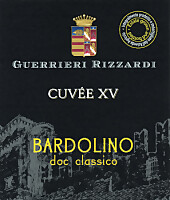
|
|
Bardolino Classico Cuvée XV 2019 |
|
| Guerrieri Rizzardi (Veneto, Italy) | |
 Corvina (60%), Rondinella (20%), Merlot, Ancellotta, Sangiovese (20%) Corvina (60%), Rondinella (20%), Merlot, Ancellotta, Sangiovese (20%) | |
| Price: € 7.20 | Score: |
 Intense ruby red and nuances of ruby red, little transparency. Intense ruby red and nuances of ruby red, little transparency. Intense, clean, pleasing and refined, starts with hints of black
cherry, plum and blackberry followed by aromas of violet, blueberry,
raspberry and geranium. Intense, clean, pleasing and refined, starts with hints of black
cherry, plum and blackberry followed by aromas of violet, blueberry,
raspberry and geranium.
 Properly tannic attack and however balanced by alcohol, good body,
intense flavors, agreeable. Properly tannic attack and however balanced by alcohol, good body,
intense flavors, agreeable.
 Persistent finish with flavors of black cherry, plum and blackberry. Persistent finish with flavors of black cherry, plum and blackberry. Aged in steel tanks and cement cask. Aged in steel tanks and cement cask. |
|
 Pasta with meat and mushrooms, Sauteed meat, Broiled meat Pasta with meat and mushrooms, Sauteed meat, Broiled meat |
|
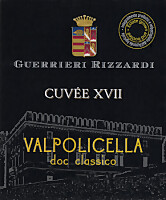
|
|
Valpolicella Classico Cuvée XVII 2019 |
|
| Guerrieri Rizzardi (Veneto, Italy) | |
 Corvinone, Corvina (80%), Merlot (10%), Rondinella, Croatina (10%) Corvinone, Corvina (80%), Merlot (10%), Rondinella, Croatina (10%) | |
| Price: € 8.20 | Score: |
 Intense ruby red and nuances of ruby red, moderate transparency. Intense ruby red and nuances of ruby red, moderate transparency. Intense, clean, pleasing and refined, starts with hints of plum, black
cherry and blackberry followed by aromas of violet, blueberry, rose and
raspberry. Intense, clean, pleasing and refined, starts with hints of plum, black
cherry and blackberry followed by aromas of violet, blueberry, rose and
raspberry.
 Properly tannic attack and however balanced by alcohol, good body,
intense flavors, agreeable. Properly tannic attack and however balanced by alcohol, good body,
intense flavors, agreeable.
 Persistent finish with flavors of plum, black cherry and blackberry. Persistent finish with flavors of plum, black cherry and blackberry. Aged in steel and cement tanks. Aged in steel and cement tanks. |
|
 Cold cuts, Pasta with meat and mushrooms, Stewed meat with mushrooms Cold cuts, Pasta with meat and mushrooms, Stewed meat with mushrooms |
|
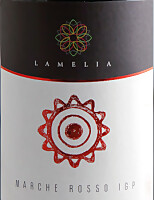
|
|
Marche Rosso 2018 |
|
| Lamelia (Marches, Italy) | |
 Syrah (50%), Merlot (50%) Syrah (50%), Merlot (50%) | |
| Price: € 9.00 | Score: |
 Intense ruby red and nuances of ruby red, little transparency. Intense ruby red and nuances of ruby red, little transparency. Intense, clean, pleasing and refined, starts with hints of black
cherry, black currant and plum followed by aromas of violet, blueberry,
blackberry, black pepper and vanilla. Intense, clean, pleasing and refined, starts with hints of black
cherry, black currant and plum followed by aromas of violet, blueberry,
blackberry, black pepper and vanilla.
 Properly tannic attack and however balanced by alcohol, good body,
intense flavors, pleasing roundness. Properly tannic attack and however balanced by alcohol, good body,
intense flavors, pleasing roundness.
 Persistent finish with flavors of black cherry, black currant and plum. Persistent finish with flavors of black cherry, black currant and plum. Syrah aged in steel tanks, Merlot aged for 10 months in barrique, at
least 4 months in bottle. Syrah aged in steel tanks, Merlot aged for 10 months in barrique, at
least 4 months in bottle.
|
|
 Stuffed pasta, Broiled meat and barbecue, Roasted meat, Stewed meat, Cheese Stuffed pasta, Broiled meat and barbecue, Roasted meat, Stewed meat, Cheese |
|
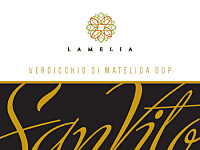
|
|
Verdicchio di Matelica San Vito 2019 |
|
| Lamelia (Marches, Italy) | |
 Verdicchio Verdicchio | |
| Price: € 11.50 | Score: |
 Brilliant straw yellow and nuances of straw yellow, very transparent. Brilliant straw yellow and nuances of straw yellow, very transparent. Intense, clean, pleasing and refined, starts with hints of pear, apple
and broom followed by aromas of citrus fruits, hawthorn, peach, plum and
almond. Intense, clean, pleasing and refined, starts with hints of pear, apple
and broom followed by aromas of citrus fruits, hawthorn, peach, plum and
almond.
 Crisp attack and however balanced by alcohol, good body, intense
flavors, agreeable. Crisp attack and however balanced by alcohol, good body, intense
flavors, agreeable.
 Persistent finish with flavors of pear, apple and peach. Persistent finish with flavors of pear, apple and peach. 8 months in steel tanks, 2 months in bottle. 8 months in steel tanks, 2 months in bottle. |
|
 Fried fish, Risotto with fish and crustaceans, Dairy products, Sauteed fish Fried fish, Risotto with fish and crustaceans, Dairy products, Sauteed fish |
|
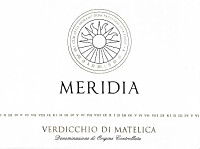
|
|
Verdicchio di Matelica Meridia 2017 |
|
| Belisario (Marches, Italy) | |
 Verdicchio Verdicchio | |
| Price: € 16.00 | Score: |
 Intense straw yellow and nuances of straw yellow, very transparent. Intense straw yellow and nuances of straw yellow, very transparent. Intense, clean, pleasing and refined, starts with hints of apple, plum
and medlar followed by aromas of hawthorn, citrus fruits, pear, peach,
broom, anise, almond and mineral. Intense, clean, pleasing and refined, starts with hints of apple, plum
and medlar followed by aromas of hawthorn, citrus fruits, pear, peach,
broom, anise, almond and mineral.
 Crisp attack and however balanced by alcohol, good body, intense
flavors, agreeable. Crisp attack and however balanced by alcohol, good body, intense
flavors, agreeable.
 Persistent finish with flavors of apple, plum and almond. Persistent finish with flavors of apple, plum and almond. 15 months in cement tanks. 15 months in cement tanks. |
|
 Stuffed pasta, Roasted white meat, Roasted fish, Broiled fish Stuffed pasta, Roasted white meat, Roasted fish, Broiled fish |
|
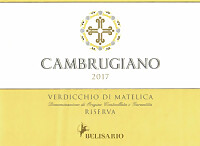
|
|
Verdicchio di Matelica Riserva Cambrugiano 2017 |
|
| Belisario (Marches, Italy) | |
 Verdicchio Verdicchio | |
| Price: € 18.00 | Score: |
 Intense straw yellow and nuances of straw yellow, very transparent. Intense straw yellow and nuances of straw yellow, very transparent. Intense, clean, pleasing, refined and elegant, starts with hints of
apple, plum and almond followed by aromas of pear, hawthorn, broom,
chamomile, peach, medlar, grapefruit, honey, rosemary and hints of
vanilla. Intense, clean, pleasing, refined and elegant, starts with hints of
apple, plum and almond followed by aromas of pear, hawthorn, broom,
chamomile, peach, medlar, grapefruit, honey, rosemary and hints of
vanilla.
 Crisp attack and however balanced by alcohol, full body, intense
flavors, agreeable. Crisp attack and however balanced by alcohol, full body, intense
flavors, agreeable.
 Very persistent finish with long flavors of apple, plum and almond. Very persistent finish with long flavors of apple, plum and almond. A small part ages for 12 months in barrique. A small part ages for 12 months in barrique. |
|
 Stuffed pasta, Roasted fish, Roasted white meat, Mushroom soups Stuffed pasta, Roasted fish, Roasted white meat, Mushroom soups |
|
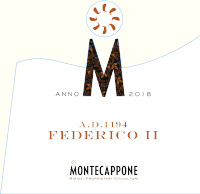
|
|
Verdicchio dei Castelli di Jesi Classico Superiore Federico II 2018 |
|
| Montecappone (Marches, Italy) | |
 Verdicchio Verdicchio | |
| Price: € 15.00 | Score: |
 Brilliant straw yellow and nuances of greenish yellow, very
transparent. Brilliant straw yellow and nuances of greenish yellow, very
transparent.
 Intense, clean, pleasing and refined, starts with hints of apple, pear
and broom followed by aromas of citrus fruits, plum, hawthorn, peach,
anise, almond and mineral. Intense, clean, pleasing and refined, starts with hints of apple, pear
and broom followed by aromas of citrus fruits, plum, hawthorn, peach,
anise, almond and mineral.
 Crisp attack and however balanced by alcohol, good body, intense
flavors, agreeable. Crisp attack and however balanced by alcohol, good body, intense
flavors, agreeable.
 Persistent finish with flavors of apple, pear and almond. Persistent finish with flavors of apple, pear and almond. 5 months in steel tanks. 5 months in steel tanks. |
|
 Pasta with fish, Sauteed white meat, Stewed meat, Fried fish Pasta with fish, Sauteed white meat, Stewed meat, Fried fish |
|
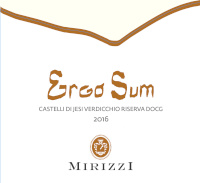
|
|
Castelli di Jesi Verdicchio Riserva Classico Ergo Sum Mirizzi 2016 |
|
| Montecappone (Marches, Italy) | |
 Verdicchio Verdicchio | |
| Price: € 65.00 | Score: |
 Brilliant golden yellow and nuances of golden yellow, very transparent. Brilliant golden yellow and nuances of golden yellow, very transparent. Intense, clean, pleasing, refined and elegant, starts with hints of
apple, plum and almond followed by aromas of hawthorn, pear, peach, medlar,
broom, bergamot, anise, saffron, linden, honey and flint. Intense, clean, pleasing, refined and elegant, starts with hints of
apple, plum and almond followed by aromas of hawthorn, pear, peach, medlar,
broom, bergamot, anise, saffron, linden, honey and flint.
 Crisp attack and however balanced by alcohol, full body, intense
flavors, agreeable. Crisp attack and however balanced by alcohol, full body, intense
flavors, agreeable.
 Very persistent finish with very long flavors of apple, plum and
almond. Very persistent finish with very long flavors of apple, plum and
almond.
 12 months in cement tanks, 48 months in bottle. 12 months in cement tanks, 48 months in bottle. |
|
 Stuffed pasta with mushrooms, Roasted fish, Roasted white meat, Cheese Stuffed pasta with mushrooms, Roasted fish, Roasted white meat, Cheese |
|
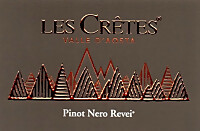
|
|
Valle d'Aosta Pinot Nero Revei 2017 |
|
| Les Crêtes (Vallée d'Aoste, Italy) | |
 Pinot Nero Pinot Nero | |
| Price: € 40.00 | Score: |
 Intense ruby red and nuances of garnet red, moderate transparency. Intense ruby red and nuances of garnet red, moderate transparency. Intense, clean, pleasing, refined and elegant, starts with hints of
cherry, plum and dried violet followed by aromas of dried rose, raspberry,
strawberry, blueberry, tobacco, chocolate, mace, leather, vanilla and
menthol. Intense, clean, pleasing, refined and elegant, starts with hints of
cherry, plum and dried violet followed by aromas of dried rose, raspberry,
strawberry, blueberry, tobacco, chocolate, mace, leather, vanilla and
menthol.
 Properly tannic attack and however balanced by alcohol, good body,
intense flavors, pleasing crispness. Properly tannic attack and however balanced by alcohol, good body,
intense flavors, pleasing crispness.
 Persistent finish with flavors of cherry, plum and raspberry. Persistent finish with flavors of cherry, plum and raspberry. 18 months in cask, 18 months in bottle. 18 months in cask, 18 months in bottle. |
|
 Broiled meat and barbecue, Roasted meat, Stewed meat with mushrooms, Hard cheese Broiled meat and barbecue, Roasted meat, Stewed meat with mushrooms, Hard cheese |
|
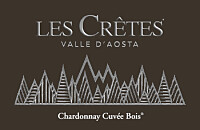
|
|
Valle d'Aosta Chardonnay Cuvée Bois 2018 |
|
| Les Crêtes (Vallée d'Aoste, Italy) | |
 Chardonnay Chardonnay | |
| Price: € 38.70 | Score: |
 Intense straw yellow and nuances of golden yellow, very transparent. Intense straw yellow and nuances of golden yellow, very transparent. Intense, clean, pleasing, refined and elegant, starts with hints of
banana, apple and acacia followed by aromas of pear, hawthorn, citron,
passion fruit, plum, grapefruit, broom, butter, croissant, hazelnut,
praline, mineral and vanilla. Intense, clean, pleasing, refined and elegant, starts with hints of
banana, apple and acacia followed by aromas of pear, hawthorn, citron,
passion fruit, plum, grapefruit, broom, butter, croissant, hazelnut,
praline, mineral and vanilla.
 Crisp attack and however balanced by alcohol, full body, intense
flavors, pleasing roundness. Crisp attack and however balanced by alcohol, full body, intense
flavors, pleasing roundness.
 Very persistent finis with very long flavors of banana, apple and
citron. Very persistent finis with very long flavors of banana, apple and
citron.
 12 months in barrique, 12 months in bottle. 12 months in barrique, 12 months in bottle. |
|
 Stuffed pasta with meat, Roasted white meat, Roasted fish, Cheese Stuffed pasta with meat, Roasted white meat, Roasted fish, Cheese |
|
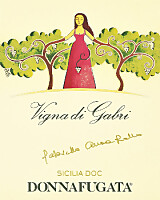
|
|
Sicilia Bianco Vigna di Gabri 2018 |
|
| Donnafugata (Sicily, Italy) | |
 Ansonica, Catarratto Bianco Lucido, Chardonnay, Sauvignon Blanc, Viognier Ansonica, Catarratto Bianco Lucido, Chardonnay, Sauvignon Blanc, Viognier | |
| Price: € 15.00 | Score: |
 Intense straw yellow and nuances of greenish yellow, very transparent. Intense straw yellow and nuances of greenish yellow, very transparent. Intense, clean, pleasing and refined, starts with hints of apple,
grapefruit and plum followed by aromas of pear, banana, acacia, hawthorn,
linden, flint and hints of vanilla. Intense, clean, pleasing and refined, starts with hints of apple,
grapefruit and plum followed by aromas of pear, banana, acacia, hawthorn,
linden, flint and hints of vanilla.
 Crisp attack and however balanced by alcohol, good body, intense
flavors, agreeable. Crisp attack and however balanced by alcohol, good body, intense
flavors, agreeable.
 Persistent finish with flavors of apple, grapefruit and plum. Persistent finish with flavors of apple, grapefruit and plum. 7 months part in steel tanks and part in barrique, 5 months in bottle. 7 months part in steel tanks and part in barrique, 5 months in bottle. |
|
 Pasta with fish, Sauteed white meat, Stewed fish, Legume soups, Dairy products Pasta with fish, Sauteed white meat, Stewed fish, Legume soups, Dairy products |
|
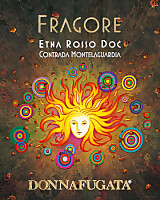
|
|
Etna Rosso Fragore 2016 |
|
| Donnafugata (Sicily, Italy) | |
 Nerello Mascalese Nerello Mascalese | |
| Price: € 57.00 | Score: |
 Brilliant ruby red and nuances of garnet red, moderate transparency. Brilliant ruby red and nuances of garnet red, moderate transparency. Intense, clean, pleasing, refined and elegant, starts with hints of
cherry, plum and dried rose followed by aromas of dried violet,
pomegranate, raspberry, carob, cinnamon, chocolate, tobacco, licorice,
leather, mace, flint, vanilla and menthol. Intense, clean, pleasing, refined and elegant, starts with hints of
cherry, plum and dried rose followed by aromas of dried violet,
pomegranate, raspberry, carob, cinnamon, chocolate, tobacco, licorice,
leather, mace, flint, vanilla and menthol.
 Properly tannic attack and however balanced by alcohol, good body,
intense flavors, pleasing crispness. Properly tannic attack and however balanced by alcohol, good body,
intense flavors, pleasing crispness.
 Very persistent finish with long flavors of cherry, plum and
pomegranate. Very persistent finish with long flavors of cherry, plum and
pomegranate.
 14 months in barrique, at least 10 months in bottle. 14 months in barrique, at least 10 months in bottle. |
|
 Stuffed pasta with meat and mushrooms, Stewed meat with mushrooms, Roasted meat, Broiled meat and barbecue Stuffed pasta with meat and mushrooms, Stewed meat with mushrooms, Roasted meat, Broiled meat and barbecue |
|
|
||||||||
|
DiWineTaste Polls
|
| |||||||
Privacy Policy | |||||||


| Copyright © 2002-2024 Antonello Biancalana, DiWineTaste - All rights reserved |
| All rights reserved under international copyright conventions. No part of this publication and of this WEB site may be
reproduced or utilized in any form or by any means, electronic or mechanical, without permission in writing from DiWineTaste. |